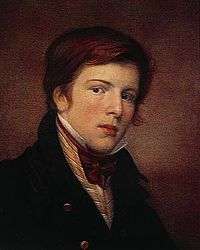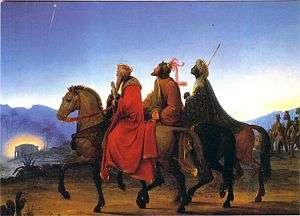Leopold Kupelwieser
| Leopold Kupelwieser | |
|---|---|
 Self-portrait (c.1813) | |
| Born |
Leopold Kupelwieser 17 October 1796 Markt Piesting, Austria |
| Died |
17 November 1862 (aged 66) Vienna, Austria |
| Nationality | Austrian |
| Occupation | Painter |

Leopold Kupelwieser (17 October 1796, Markt Piesting – 17 November 1862, Vienna) was an Austrian painter, often associated with the Nazarene movement
Life
He was the son of Johann Baptist Georg Kilian Kupelwieser (1760–1813), co-owner of a factory that produced tableware.[1] His talents were recognized at an early age by the sculptor Franz Anton von Zauner and by the time he was twelve, he was already attending the Academy of Fine Arts, Vienna.[2]
During a stay in Rome in 1824, he came under the influence of Friedrich Overbeck and the Nazarene movement.[2] After the death of Alexei Sergeyevich Berezin, a Russian nobleman who had been his patron there, he returned to Vienna and earned his living primarily as an illustrator and portrait painter, although he is also known to have painted shop signs.[3]
He was a member of the "Schubertianern" (friends of Franz Schubert), a group that often got together for summers at the Schloss Atzenbrugg, west of Vienna. In 1826, he married Maria Johanna Evangelista Augustina Stephania Theodora Lutz, an occasion which was marked by Schubert's composition, the "Kupelwieser Waltz", (never written down, but passed along by the family and later transcribed by Richard Strauss).
In 1837, he became Professor of history painting at the Academy[3] and, in 1850, was awarded the Knight's Cross of the Order of Franz Joseph. Virtually all of his later work involved religious altarpieces and frescoes. At the age of sixty he fell ill, apparently due to the rigors of painting on wet lime, and never recovered his health.[2]
In 1894, a street was named in his honor and a commemorative stamp was issued in 1996. He is a character in Das Dreimäderlhaus (House of the Three Girls, 1916), a pastiche operetta, derived from the music of Schubert by Heinrich Berté, based on the novel Schwammerl (Mushroom, one of Schubert's nicknames) by Rudolf Hans Bartsch. His brother was the theatrical director Josef Kupelwieser, who wrote the libretto for Schubert's opera Fierrabras.
References
- ↑ Eva Wald: Die Anfänge der Industrie des Wiener Beckens und ihre geographischen Grundlagen. Vienna University dissertation, 1954, Permalink Österreichischer Bibliothekenverbund, pg. 221.
- 1 2 3 Bernhard Grueber (1883), "Kupelwieser, Leopold", Allgemeine Deutsche Biographie (ADB) (in German), 17, Leipzig: Duncker & Humblot, pp. 405–407
- 1 2 Rupert Feuchtmüller (1982), "Kupelwieser, Leopold", Neue Deutsche Biographie (NDB) (in German), 13, Berlin: Duncker & Humblot, pp. 312–313 ; (full text online)
Further reading
- Constantin von Wurzbach: Kupelwieser, Leopold. In: Biographisches Lexikon des Kaiserthums Oesterreich, Vol. 13 (1865), pgs.392–396 (Online at Austrian Literature Online) (Fraktur)
- Rupert Feuchtmüller: "Kupelwieser Leopold". In: Österreichisches Biographisches Lexikon 1815–1950 (ÖBL). Vol. 4, Austrian Academy of Sciences, Vienna 1969, p. 359 f. (Direct links to "p. 359", "p. 360")
- Rupert Feuchtmüller: Leopold Kupelwieser und die Kunst der österreichischen Spätromantik, Österreichischen Bundesvaerlag, 1970
- Rita Steblin: Die Unsinnsgesellschaft: Franz Schubert, Leopold Kupelwieser und ihr Freundeskreis, Vienna, Böhlau, 1998 ISBN 3-205-98820-5
External links
| Wikimedia Commons has media related to Leopold Kupelwieser. |
- The Waltz in G Flat Major (Kupelwieser Waltz) @ YouTube
- "Works by Leopold Kupelwieser". Zeno.org (in German).
- Leopold Kupelwieser in: Austria-Forum (in German) (at AEIOU)